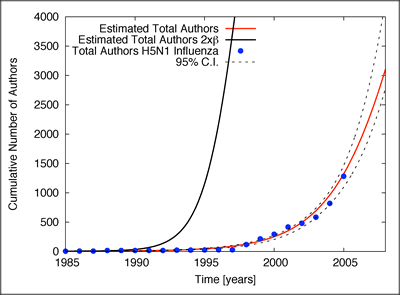— Sir Isaac Newton, 1676 —
- “Compared to most diseases, scientific ideas spread slowly, taking years to become adopted by a significant number of practitioners.”
- “Useful ideas may never be forgotten, leading to very long infectious periods . . .”
- “Measures of scientific productivity can be produced by considering numbers of papers and authors over time . . .”
What if electricity had been discovered 20 years earlier?
While we don't know how large the economic or scientific impact might have been of turning the lights on for an additional generation, OSTI operates as if the benefits would have been significant.
OSTI is doing applied research to explore ways to speed the diffusion of scientific knowledge and accelerate scientific progress. The intention is to save years and even decades in discovery time for our nation's researchers.
A fortuitous circumstance: The mathematics that describes knowledge diffusion has much in common with well-developed mathematics that describes infectious disease. Thus, OSTI's diffusion research team used models from the spread of infectious disease, or epidemiological models, to look at whether the spread of ideas could be measured and modeled, and if so, whether the “rate of infection” for ideas could be related to future scientific productivity. In other words, if ideas are contagious — and if OSTI can increase the rate of “infection” (through search tools, resources, and education) — can scientific productivity be increased?
This could have broad implications for increasing the pace of discovery, predicting viability for scientific fields and evaluating long-term funding opportunities.
So, what about it? Would researchers "catch" an idea faster if the "contact rate" between scientists were increased?
While findings from the first case studies are preliminary, and there is still much work to be done, it turns out that the spread of ideas can be measured and modeled. In addition, the diffusion of knowledge is sensitive to the contact rate and can be accelerated.
For example, the number of authors publishing on the subject of Bird Flu (H5N1) over time is shown in the graph below. Doubling the contact rate (2x β, or the solid black line) between authors shows a discovery time savings of approximately one decade.

"The number of authors publishing on the subject of Bird Flu (H5N1) over time is shown. Doubling the contact rate (2x β, or the solid black line) between authors shows a discovery time savings of approximately
one decade."
These early findings are discussed in Report for the Office of Scientific and Technical Information: Population Modeling of the Emergence and Development of Scientific Fields (579-KB PDF) and in Notes toward a Nanotech Timeline (584-KB PDF).
Case studies include:
- Carbon Nanotubes
- Cosmological Inflation Theory
- Cosmic String Theory
- Prions
- Quantum Computing
From Notes toward a Nanotech Timeline:
- Nanotechnology and Nanotubes
Chart Description 
Between 1991 and 2005, the rate of new nano articles increased considerably, doubling every 3.3 years.
For other OSTI innovations, visit OSTI's milestones page.
See where OSTI fits into the nation's science cyberinfrastructure.






